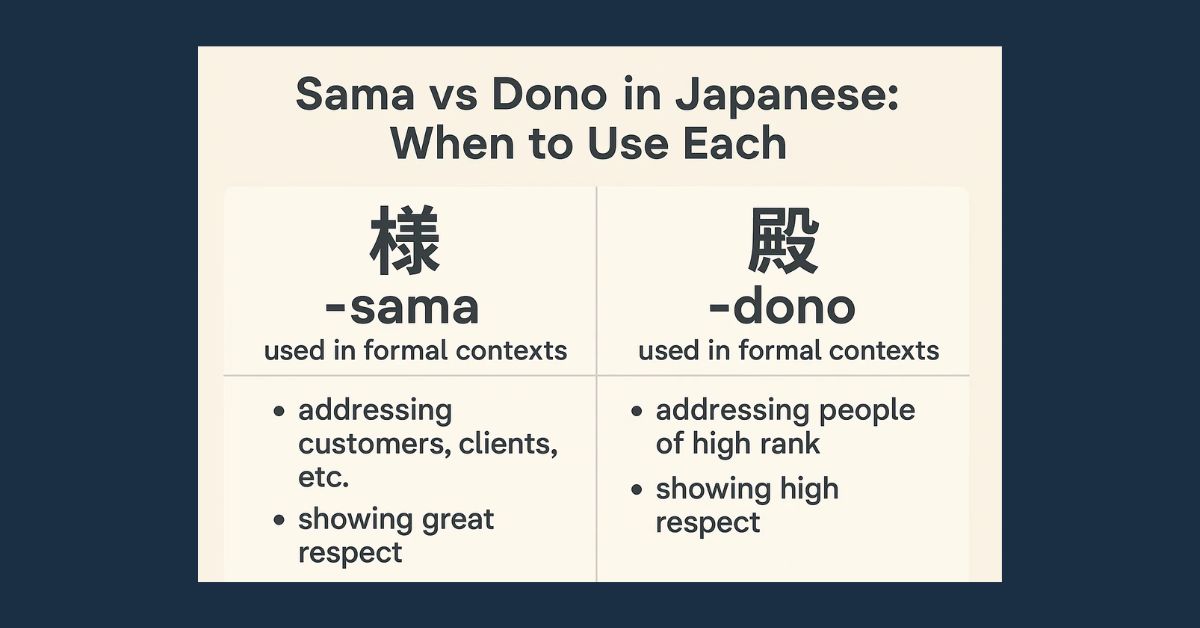In Japanese, sama is a really respectful honorific that is used to express deep respect. Sama, meaning Japanese, relates to mentioning gods, valued customers, or royals such as using “Kami-sama” when referring to a god. It indicates a clear social divide, where the speaker regards the other individual as way above themselves. You’ll find Japanese honorifics such as sama frequently used in business or formal environments.
By difference, dono is more old and derives from out-of-date Japan, in which it expressed polite respect among equals in the samurai class. The dono meaning Japanese translates as “lord” or “master,” but it’s hardly ever used in modern usage. Nevertheless, dono honorific meaning lives on in official letters or historical plays. Understanding the difference between sama and dono makes you sound respectful and in-the-know when you speak Japanese.
The Respectful World of Japanese Honorifics
Japanese society respects, and that respect is expressed in the form of special name endings known as honorifics. The most respectful of these is sama. Sama meaning Japanese is to express great respect, used commonly for gods (Kami-sama), customers (okyaku-sama), or royalty. It has a definite status of hiring the individual you’re addressing above you. For customer service or formal letters, sama is used widely in modern Japan.
Next, there’s dono, which you may hear in out-of-date samurai films or read in history books. The dono meaning Japanese is just like “lord” and originally was used between important individuals of equal status. Nowadays, the dono honorific meaning is a little outdated, but you’ll still hear it in formal Japanese letters or period dramas. Knowing the difference between sama and dono makes language students steer clear of mistake-inducing errors and better relate to Japanese culture.
Sama: The Ultimate Modern Honorific
The sama meaning Japanese indicates profound respect and is employed for gods, customers, or royalty in current life. Although the dono meaning Japanese appears ancient and stilted, sama continues to be the preferred option for respectful and polite speaking in the current Japanese honorifics system.
When to Use Sama
The sama meaning Japanese sends great respect and is employed in several formal contexts today. It is unlike the dono, which means Japanese, which sounds old-fashioned. Sama naturally suits modern language and manners of address.
- Referring to gods and divinities: Employ “Kami-sama” when telling gods or spirits.
- Customer service environments: Employees use “okyaku-sama” to give customers the greatest respect.
- Formal letter writing: Names in emails or letters may end in “sama” to be very polite.
- Addressing royalty: Names such as “Hime-sama” are used for princesses or other royal stars.
- Business: Businesses utilize “sama” when communicating with clients or business partners.
- Online ordering or delivery services: On receipts or packages, you will have “sama” printed together with your name.
Real-world example:
店員: いらっしゃいませ、お客様。何かお手伝いできますか?
Ten’in: Irasshaimase, okyaku-sama. Nanika otetsudai dekimasu ka?
(Clerk: Welcome, honored customer. May I help you with something?)
Dono: The Historical Honorific of Equals
The dono Japanese meaning was created from ancient days, spoken between samurai or individuals of roughly equal high rank. As opposed to the sama Japanese meaning, which respects a low to a high rank, dono was mostly respectful between equals. In the present day, the dono honorific Japanese meaning largely occurs in formal letters, court documents, or ancient Japanese plays.
The Historical Context of Dono
In out-of-date Japan, dono meaning Japanese was a sign of respect between nobles or samurai who were of the same rank. It derived from tono, meaning “lord,” and expressed honor without building a large gap of power. Unlike sama, meaning Japanese, which builds a noticeable higher-lower difference, dono was less irregular. It is therefore unique in the universe of Japanese honorifics where rank within society is typically very different.
Through time, dono honorific meaning became less used in everyday life but remained alive in formal and traditional contexts. You may view it in Japanese legal agreements, old-fashioned letters, or see it employed in period dramas. Despite not being heard these days, knowing how sama and dono differ aids language students in knowing how status functioned in Japan’s past. It also explains how language and history are attached in Japanese society.
When to Use Dono in Modern Japan
Nowadays, the dono meaning Japanese is largely used in really formal or traditional contexts. It sounds more old-fashioned in contrast to sama meaning Japanese, still widely used in everyday life. Nevertheless, dono conveys huge respect in writing, services, and historical stories in Japanese honorifics.
- Formal written communication: Employed in extremely polite letters, such as “Yamada-dono.”
- Traditional arts and ceremonies: Used in tea ceremony titles or fighting arts ceremonies.
- Official documents: Employed for positions such as company directors in formal documents.
- Historical dramas: Frequently employed by samurai or nobles in Japanese era dramas.
- Official award notifications: Might occur when giving someone an award of title.
- Classical Japanese composition: Common in historical writings and works about out-of-date Japan.
Historical example:
武田: 上杉殿、この手紙をお読みください。
Takeda: Uesugi-dono, kono tegami o oyomi kudasai.
(Takeda: Lord Uesugi, please read this letter.)
Sama vs Dono: Key Differences in Modern Usage
When deciding between sama and dono in today’s Japanese, it’s important to understand the key differences that shape how each one is used.
| Aspect | Sama (様) | Dono (殿) |
| Level of formality | Extremely high | Extremely high but archaic |
| Implied relationship | Vertical (up to recipient) | Historically horizontal |
| Common modern contexts | Customer service, deities, nobility | Formal documents, historical reference |
| Gender association | Gender-neutral | Traditionally male-oriented but technically neutral |
| Perceived modernity | Contemporary | Archaic/traditional |
As we’ve seen in our guide to Japanese honorifics, choosing between sama and dono says a lot about the speaker’s determination and the social setting they’re in.
Related Post: Oi Oi Oi Meaning: What It Really Means in Japanese
Common Mistakes When Using Sama vs Dono
Most students confuse sama and dono, and these get used in ungainly or affected interactions. Understanding the dono meaning Japanese and sama meaning Japanese prevents such minor yet critical errors in Japanese honorific usage.
- In customer service contexts: Sounds too old and out of place for modern polite language.
- Self-use: Never apply sama or dono to yourself. It sounds proud.
- Overuse: Overusing sama makes your speech unnatural or rigid.
- Combining with informal terms: Mixing high-level honorifics with slang or informal language causes confusion.
- Used in emails or texts in a casual manner: It sounds too affected or difficult in casual writing.
- Applied to friends or equals: It establishes an awkward power disparity and sounds uncool.
Knowing the distinction between sama and dono enables you to communicate more naturally and respectfully both in modern and old-fashioned Japanese situations. It also proves cultural sensitivity, which is equally vital as grammar when learning the language.
When Neither Sama nor Dono is Appropriate
Other times, employing sama or dono is not the best option, particularly in informal or day-to-day contexts. Although the sama meaning Japanese and dono meaning Japanese are respectful, there are other honorifics for Japanese that will be more suitable depending on the environment.
- San (さん): The most popular and informal honorific for everyday use safe for nearly everybody.
- Sensei (先生): Employed for instructors, physicians, or master craftsmen to express polite respect.
- Name only: Close relatives or friends tend to forget honorifics altogether in informal conversation.
- Title only: In the work environment, individuals may use “Manager” or “Director” in lieu of a name.
- Kun (くん): Used often for young men or junior colleagues in informal situations.
- Chan (ちゃん): An friendly or cute honorific, employed when addressing children, pets, or close friends.
Not knowing when to forget sama or dono keeps you from sounding natural and accepting with native Japanese speakers. It’s simply a matter of selecting the proper degree of politeness for the situation.
Cultural Implications Beyond Language
The use of Japanese honorifics such as sama and dono indicates more than grammar; it indicates deep-seated cultural values. Knowing the meaning of sama Japanese and dono Japanese provides access to understanding how Japanese individuals think about history, relationships, and respect.
- Historical consciousness: Dono maintains feudal Japan’s customs in language and ceremony.
- Hierarchical consciousness: Sama reminds us the degree to which Japanese society respects status and expressing respect in the direction up.
- Contextual conversation: Honorifics vary based on context, representative of how sensitive individuals are to social context.
- Group harmony: Using the correct honorific ensures polite group interactions and saves from crime.
- Non-verbal respect: Even without clear words, honorifics convey care, modesty, and formality.
Learning when and how to apply dono or sama isn’t just the matter of speaking properly, it’s the matter of greed, the essence of Japanese society. It’s one little thing that completes a lot when it comes to connection and communication.
Q&A: Common Questions About Sama vs Dono
What’s the main difference between sama and dono?
Sama shows vertical respect in modern speech, while dono expresses historical, equal-status respect from feudal Japan.
Is dono more respectful than sama?
No, sama is more respectful today. Dono is formal but feels old-fashioned and is hardly used in daily life.
Can foreigners use sama and dono?
Yes, but use sama in polite settings only. Avoid dono unless writing formal letters or referencing traditional culture.
Do Japanese people still use dono in everyday speech?
Not really. Dono is mostly used in official letters, legal documents, or historical Japanese dramas, not daily talk.
When to say dono in Japanese?
Use dono in very formal writing, traditional ceremonies, or when speaking in a historical or respectful context.
When to use Sama and Dono?
Use sama for gods, customers, or royalty. Use dono in formal letters or traditional, respectful ancient situations.
How to use Sama correctly?
Attach sama after names in formal speech, writing, or business. Never use it for yourself; it’s seen as superior.
Conclusion: Navigating Sama vs Dono in Modern Japan
Mastering the difference between sama and dono teaches you how respect and relationships are done in Japan. Sama is used even today to express great respect, and dono provides us with an awareness into Japan’s past, particularly in out-of-date society. For language learners, it’s not all about grammar, it’s about observing how words represent more deep social rules. Being able to use these Japanese honorifics at the right time shows that you value the culture.
Whether you’re an anime fan, a businessman, or simply learning the language for fun, the sama vs dono divide proves how Japan employs language to convey tradition and meaning from generation to generation.

